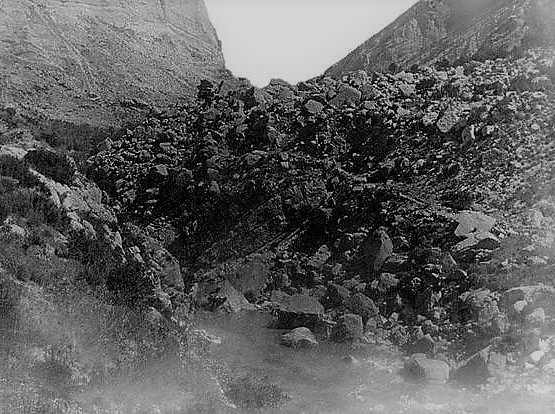A GORGE IN THE LEGEND OF THE SEGRE
In 1984, I was driving my car to fish the Basella Oliana reserve from Nargó, a small village nestled and perched on the last granite rocks of the Sierra de San Juan, where the Segre River is tamed by the reservoir. The road is terrifying, full of curves bordering precipices that forced the driver to drive at a more than moderate speed to avoid plummeting into the dark, deep waters of the reservoir. Well past the Espluvins Bridge, I always noticed the large boulders that had fallen from the Sierra de Turp and literally tumbled into the waters of the Segre. The sight was like that of an enormous cluster of abominable stones of prehistoric dimensions.
Many years later, I wondered about the origin of that terrifying spectacle and decided to investigate. Pere Bach had told me about catching an eleven-and-a-half-kilo trout in the Congost dels Espluvins in the late 1950s, an event that also contributed to increasing my innate curiosity and leading me to investigate and study everything that was already shrouded in a certain dread, awakening sensations of dark and horrific events.
The fearsome gorge lies between the last foothills of the Sierra de Turp and the vertical walls of the great Aubenç mountain. The Aubenç cliffs overlook the road on the west bank of the river, while the cluster of large boulders that fell from the Turp mountains are located on the eastern bank of the river, now a swamp.
The Spanish writer Francisco Zamora, one of the last Enlightenment writers, wrote with great accuracy in his book Travel Diary through Catalonia in 1788: “We found a place called Espluvins, and a wind blows from under the river, because when it carries a lot of water, you can see how it lifts it. This wind is called Espunyola… Further ahead, there is a kind of reservoir from which wood is taken and carried, which is then dragged along a path on the eastern side, where it is thrown back into the water. During this laborious operation, wood is lost through the hole… from which it is said that everything that falls in never reappears.”
In 1896, the newspaper La Vanguardia, referring to the old inn of Espluvins, said of the place in its posthumous report: “Attached to steep cliffs, it was practically suspended high above the bed of the Segre, which twists and turns at great depths in its narrow and deep channel, enclosed between steep mountains. From the very high and steep mountains that backed the inn and are covered in thick moss, a cascade of water falls from an immense height, cascading in thin threads, from which circumstance derives the name Espluvins.”
Hence the apt Catalan name Espluvins, which is a single word that defines the process of water cascading from the mountain, but once divided by the rocky cliff into multiple, very fine threads, it remains as a continuous and persistent drizzle.
Prince Felix de Lichnowsky, in his memoirs of the siege of Vielha by the Carlists, also mentions that upon reaching Oliana, “the valley closes in like a wall of rocks, leaving a narrow opening through which the waters of the Segre escape. Here and there we find isolated houses, built on pieces of granite that hang like eagles’ nests from the rocks and serve as shelter for hunters, muleteers, and smugglers.”
The place today remains very wild and, above all, unwelcoming. Long before the road from Oliana to Coll de Nargó was built in 1898, there was an inn there, literally built like an eagle’s nest, attached to one of the walls of the dizzying cliffs.
The Hostal dels Espluvins was built in the late 1780s and was accessed via a winding, rocky path that bordered the Segre River. It was the only place to spend the night, feed the horses and mules, or rest between days of hunting.
To be continue…
~ Carles V.

